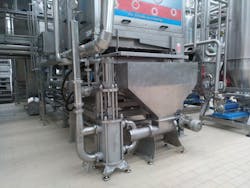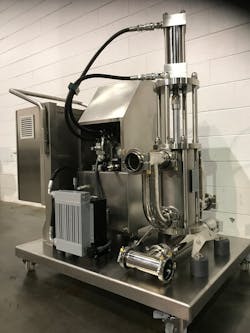Moving products around during processing is an inherent need for most medium and large-scale food manufacturers. The texture and viscosity of food is not only an important quality parameter, but it also influences how it behaves during production and processing. Therefore, the texture and viscosity of food should also influence the choice of handling and treatment equipment used in the manufacturing process.
The exact requirements obviously depend on many factors, including the nature of the product itself and the processes involved. However, they tend to fall into two types: those which can be pumped and transported in pipes; and those which need to conveyed, usually by mechanical belts or similar systems.
Many problems can arise because the pumps used have not been specifically designed for the applications or conditions that they are being used for. It is also worth remembering that it is not just simple liquids that can be pumped. With the right equipment, a range of products including powders, pastes and mixtures of liquids and solids can also be pumped through suitable pipe work and equipment. There are advantages to this approach, particularly the ability to avoid contamination of products during processing, as well as being able to maintain processing temperatures, viscosity and more. However, while many types of pump are suitable for use in the food industry, traditional pumps can be expensive to maintain, may have low flow rates, result in product damage or result in a low pressure drop.
Assessing difficult products
One of the issues with pumping is the potential to damage product. This is particularly important when handling high value viscous products such as honey, treacle, custards and creams, where any loss of product can be financially damaging. The viscosity of different fluids can be affected, resulting in issues such as runny or separated sauces or unwanted churning of dairy products. For materials containing solids such as fruit mixtures, the wrong type of pump can easily damage the solid fraction, reducing quality or, at worst, removing the very aspect of your product that you are trying to preserve.
Although the physical and behavioral properties of many foods are well documented, in more complex cases it is necessary to fully understand the food product to be handled to specify the right pump for both the product and the process. It may be possible to do this with simple measurements taken in situ, or laboratory analysis may be required.
The temperature of the product is important as physical properties will vary with temperature. Viscosity is a measurement of resistance to flow and is therefore is an important consideration, and information on particle size is also required. These could include anything from ground spices to whole fruits or pieces of meat, and everything in between. The chemical composition — in the event the material is acidic — will also need to be known so that the most cost-effective materials can be used to produce the pump.
Among other things, the shear sensitivity of the fluid reflects how likely it is to be damaged by the impeller of the pump. The physical characteristics of some products will change after exposure to high-shear stresses, and while this may be beneficial in some circumstances — such as turning cream into butter — it is not in some others (for example when wanting to produce cream). Vapor pressure will also need to be considered to prevent issues such as flashing or cavitation.
Because viscosity is a key part of the texture of food and beverage products, processing operations should not have an adverse effect on it. Factors such as pumping, heating, cooling and passing through pipe work all have the potential to affect viscosity, with the exact effects depending both on the liquid itself and the way it is handled.
Types of pump
As well as being designed to handle your product, a pump needs to fulfil the normal requirements of food handling equipment, such as clean-in-place (CIP) and sterilize-in-place (SIP). Depending on the range of products handled and product complexity, CIP or SIP may be required several times a day between production batches. There are many different types of sanitary pumps that are suitable for use in the food industry, including rotary lobe, rotary piston, reciprocating positive displacement, progressing cavity, peristaltic hose and air-operated double diaphragm designs. Problems arise not only because of the high costs of traditional pumps, but also because lobular pumps have low flow rates. In addition, using progressive cavity pumps can break the product, while double diaphragm pumps result in a low pressure drop.
Centrifugal pumps are typically used for materials such as batters, oils and beverages. Common uses for positive displacement pumps include icing, dough, fruit fillings and purees, baby food, tomato paste, sauces, cream, cheese, dressings, mayonnaise, meat emulsions and many more.
More recently, new purpose-designed, reciprocating positive-displacement pumps have been developed to handle delicate and viscous foods without damage in the food and pharmaceutical industries.
Back to the drawing board
Having seen the results of using the wrong pump for the wrong job, HRS went back to the drawing board to develop a pump which could handle very delicate and viscous food products without damage while working at high pressure in heavy-duty applications in the food and pharmaceutical industries. The result was a purpose-designed reciprocating positive-displacement pump: the HRS BP Series Piston Pump.
Positive displacement pumps have an expanding cavity on the suction side of the pump and a decreasing cavity on the discharge side. Liquid flows into the pump as the cavity on the suction side expands and is forced out of the discharge side as the cavity collapses. The BP Series, for example, features a hygienic design that incorporates a separator fitted between the piston and the hydraulic chamber to ensure that there is no contact between the product chamber and the hydraulic oil, ensuring no oil encounters the product.
With an adjustable flow — which can range from a minimum of 80 gallons/hour to a maximum of 5,280 gallons/hour — and featuring a high pressure drop of up to 435 psi, the BP Series is suitable for a wide range of high viscosity fluids that are shear-sensitive and that contain large particulates. Clap valves allow pumping of whole fruits or vegetables, and an alternative version with a pneumatic cylinder can be supplied for low-pressure applications of less than 5 bar.
To allow food manufacturers to see the benefits for themselves, HRS also created the HRS BPM Series. The BPM is a mobile version of the standard BP Series pump but is mounted on a mobile skid unit for easy movement, allowing it to be used across multiple production lines and locations. This makes it popular with food manufacturers producing short runs of specialty products and numerous trials, as they can enjoy the benefits of a BP Series pump without the need to invest in a dedicated pump for each line, resulting in considerable capital savings.
Matt Hale is the international sales & marketing director at HRS Heat Exchangers.

